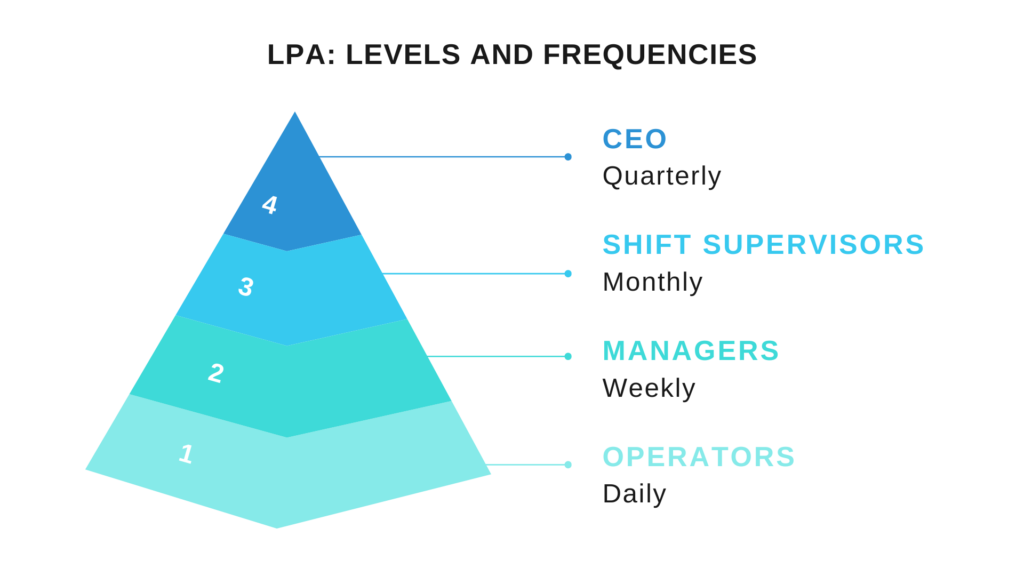Layered Process Audits (LPAs) are very useful to verify that production processes are carried out in accordance with the defined standards and thus avoid future quality problems. In this article we explain what the review and validation of these audits consist of and why it is highly recommended to carry out their management with the help of a software such as Mapex.
What are Layered Process Audits?
Layered Process Audits (LPAs) system is a quality tool of review and standardization based on verifying the correct execution of a production process.
It is a technique that aims to ensure compliance with standards and instill its importance to all members of the organization. This allows the company to anticipate quality problems, reduce nonconformities to a minimum and boost efficiency in the shop floor.
The automotive sector was a pioneering industry when it came to implementing LPAs. In fact, OEMs such as General Motors require their suppliers to establish this verification system in their factories.
However, it is becoming increasingly usual for companies in other sectors to implement Layered Process Audits as well, especially those organizations that are committed to the Lean methodology and other strategies to achieve operational excellence such as the PDCA cycle.
The three key elements of Layered Process Audits
Here we look at the three key elements for implementing the LPA system in an industrial company.
1. The auditors
In Layered Process Audits, the group of auditors is made up of professionals from the quality area, but also from other departments of the organization and from various levels of management, including executive leadership.
Another characteristic of this type of internal controls is that these audits are performed at a predetermined frequency depending on the level of the auditor. As can be seen in the pyramid, while operators usually carry them out daily, managers conduct audits approximately once every three months.

In this way, auditors verify each other, and the company reduces the possibility of overlooking possible non-compliance with the standards defined for the production process. With LPAs it is also becomes clear that quality is an issue that concerns all members of the organization.
2. The checklist
Layered Process Audits normally focus on specific processes, on which variability and non-compliance with the standard can be very harmful to the company: higher costs due to nonconformities and rework, occupational safety problems, etc.
These audits are also designed so that any person, regardless of their position in the company or specialization, can carry them out without the need for specific training.
Additionally, it must be considered that the elaboration of the checklist is not only the responsibility of the Quality department. Operations must also be involved in this task; they are employees who know first-hand how the execution of the manufacturing process can affect the quality of a product.
Besides, the checklist should not exceed 10 closed-ended questions (Yes/No, Pass/Fail, OK/NOK) and the auditor must be able to answer them all in a maximum of 15 minutes.
The questions should be easy to understand. It is equally important to make it very clear to the auditor what evidence to look at in order to decide whether the process is being performed (or not) correctly.
3. The action plan
Each of the questions that make up the Layered Process Audit checklist must be accompanied by an effective action plan. It is important that when the auditor reports the nonconformity, containment measures and, if necessary, corrective actions are put in place to address the root cause.
To get the most out of this system, companies should also track LPA’s effectiveness. This means monitoring metrics such as audit completion rates, pass rates, on-time audit completion, number of audits completed, mitigation closure rates, etc.
The benefits of LPAs
In many cases, rework, customer complaints or waste is due to a lack of process standardization or non-compliance with approved methods.
That is why more and more industrial companies are using the Layered Process Audits system. It is a proactive approach to control production processes, enhance the quality of work and improve the company’s bottom line.
LPAs have a positive impact on:
- Cost reduction: early detection of errors means less waste, less reprocessing, less raw materials used, fewer warranties for manufacturing defects, less compensation or penalties for non-compliance with occupational risk prevention measures, etc.
- Increasing the level of customer satisfaction through improved product quality.
- Compliance with standards and elimination of process variability.
- The development of a culture of continuous improvement in the company.
- Better communication, more transparency and collaboration between departments.
Manual vs. digital management of LPAs
The digitization of Layered Process Audits is essential to maintain this system over time and take advantage of its full potential. Otherwise, the manual management of these inspections can lead to:
- Low audit completion rates: scheduling a large volume of audits and reminding employees to perform them without the help of software is a very complicated task for companies.
- Lack of visibility of nonconformities: recording errors on paper not only jeopardizes information security, but also prevents easy and quick access to information.
- Delays in audit reports: manual data entry and analysis in spreadsheets hinders the follow-up of corrective actions or the rapid detection of potential problems and the implementation of preventive actions.
- Quality leaks and dissatisfied customers: ineffective management of LPA does not help to reduce quality problems and can even damage the company’s reputation.
Mapex helps you to implement the Layered Process Audits system
Mapex Quality module incorporates the necessary tools to configure, plan and perform Layered Process Audits.
Our platform allows companies to register the different levels, the frequency of controls, the processes to be audited and the inspection points. The software has a planning section, which shows the audits already assigned and scheduled, as well as a proposal for future audits, according to the defined frequency and sequence (which can be displayed in Gantt format).
From the Mapex screen, auditors can also view and pass the checklist inspection points and assign an action. Finally, the software generates historical reports so that the company can keep track of all audits performed, inspection points answered, and possible actions generated.
Fill out this contact form if you want to know more about the benefits of implementing the Mapex MES system. Centralize in a single platform the management of all your audits and inspections, and increase transparency, efficiency and information analysis capacity in your company.



